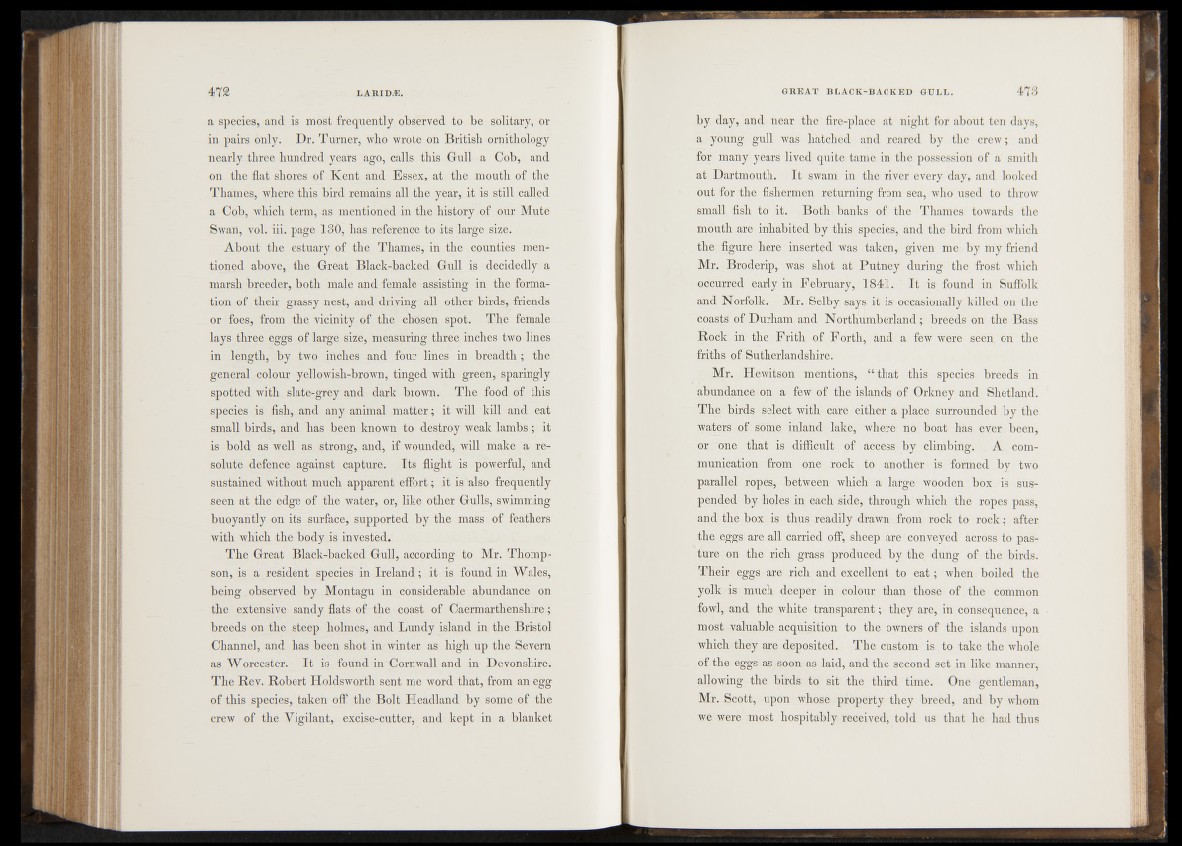
a species, and is most frequently observed to be solitary, or
in pairs only. Dr. Turner, who wrote on British ornithology
nearly three hundred years ago, calls this Gull a Cob, and
on the flat shores of Kent and Essex, at the mouth of the
Thames, where this bird remains all the year, it is still called
a Cub, which term, as mentioned in the history of our Mute
Swan, vol. iii. page 18t), has reference to rts large size.
About the estuary of the Thames, in the counties'mentioned
above, the Great Black-backed Gull is decidedly a
marsh breeder, both male and female assisting in the formation
of their grassy nest, and'driving all other birds, friends
or foes, from the vicinity of the: chosen spot. The female
lays three eggs of large size, measuring three inches two-lines
in length, by two inches and four lines in breadth; the
general colour yellowish-brown, tinged with green, sparingly
spotted with slate-grey and dark brown. The food of this
species is fish, and any animal matter; it will kill and eat
small birds, and has been known to destroy weak lambs ;> it
is bold as well as strong, and, if wounded, will make a resolute
defence , against capture. Its flight is powerful, and
sustained without much apparent effort; it is 'also frequently
seen at the edge of the water, or, like other Gulls, swimming
buoyantly on its surface, supported by the mass of feathers
with which the body is invested.
The Great Black-backed Gull, according $!> Mr. Thompson,
is a resident species in lreland; it--is found in Wales,
being, observed by Montagu in considerable abundance on
the extensive sandy flats of the coast of Caermarthenshire;
breeds on the steep holmes, and Lundy island in the Bristol
Channel, and has been shot in winter as high bp the Severn
as Worcester. I t is found in Cornwall and in Devonshire.
The Rev. Robert Holdsworth sent me word that, from an egg
of this species, taken off the Bolt Headland by some of the
crew of the Vigilant, excise-cutter, and kept in a blanket
by. day, and near the fire-place at night for about ten days,
a young gull was hatched and reared by the crew; and
for many years lived quite, tame in the possession of a smith
at Dartmouth. It swam in the river every day, and looked
out for the fishermen returning from sea, who used to throw
small fish to it. Both> banks of the Thames towards the
mouth are inhabited by this species, and the bird from which
the' figure here inserted was -taken, given me by my friend
Mr. Broderip, was shot at Putney during the frost which
occurred early, in February, 1841. ' I t is found in Suffolk
and Norfolk. Mr. Selby says it is occasionally killed , on the
coasts' of Durham and Northumberland; breeds on the Bass
Rock in the Frith of Forth, and ,a few were seen, on the
friths of Sutherlandshire.
Mr. Hewitson mentions, “ that this species breeds in
abundance: on a few of the islands of Orkney and Shetland.
The birds ».select with care either a place surrounded by the
waters of some inland lake, where no. boat has ever been,
or ; “one that is difficult. of access by climbing. A communication
from one , rock to an other is formed by two
parallel Tope's, between which a large wooden box is suspended
by holes in each side, through' which the ropes pass,
and the box is thus readily drawn from rock to rock; after
the. eggs are .all carried off> .sheep are conveyed across to pasture
on the rich grass produced * by the, dung of the birds.
Their eggs are rich and excellent to e a t; when boiled the
yolk is much deeper in colour than those of the common
fowl, and the white transparent; they are, in consequence, a
most valuable, acquisition to the owners of the islands upon
which they are deposited. The custom is to take the whole
of the eggs as ,soon as laid, and the second set in like manner,
allowing the birds to sit the third time. One gentleman,
Mr. Scott, upon whose property they breed, and. by whom
we were most hospitably received, told us that he had thus